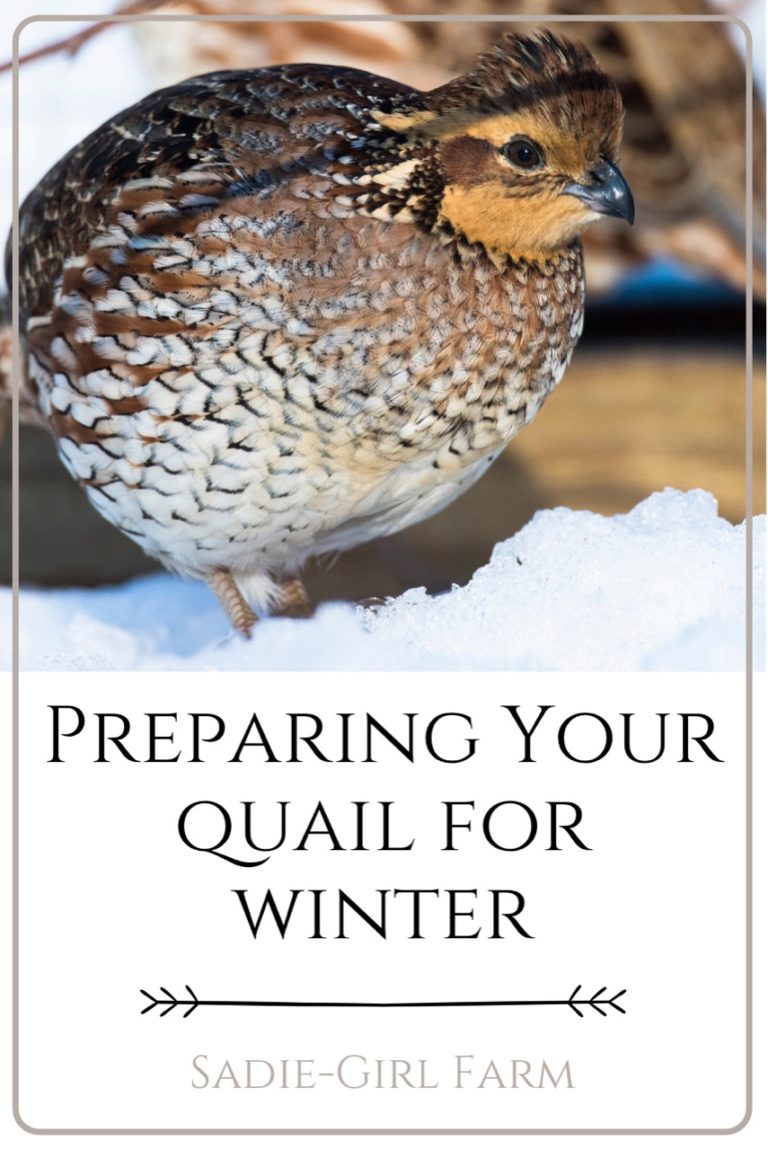Caring for Quail in the Winter

(Disclosure: Some of the links below are affiliate links, meaning, at no additional cost to you, I will earn a small commission if you click through and make a purchase. I only ever provide links to products I use myself and love.)
One of the things that originally drew us to raising quail, was how easy they are to care for. Their needs are pretty basic, and once you know what they are, quail can quickly become one of the easiest animals to raise on your homestead. This goes for winter time too!
Coturnix Quail are actually super cold-hardy. They do just fine during big snows and well-below freezing temperatures. We raise 2 varieties of Coturnix Quail here on our little farm… Celadon Quail (blue egg layers) and our Blue Ridge Jumbos.
There are many many breeds of quail, some of which do NOT do well in cold temps. So make sure to research your quail breeds before you decide to purchase, and compare their needs to your local climate. Coturnix are a domesticated quail breed which are very easy for the beginner quail keeper to raise. Which is why I said, “sign me up!”. I like anything easy, that is not going to add a ton to my already full workload!
So here in the mountains of Western North Carolina, we get about 4 months of true winter weather. Our lows can dip down to single digits and we get a fair amount of snow, especially up here in the mountains. After a little bit of trial and error, we have found a winter “quail system” that works perfect for us and our birds.
Winter shelter for your quail
There are a couple things you need to adjust in the winter to keep your quail healthy and happy. First, they need a place to get out of the wind, hunker down, and snuggle (or “covey up” in quail talk) for the night.
During the summer, quail can overheat (like any animal), so we make sure they have plenty of cross ventilation in their pens and some shade.
In the winter, that cross ventilation is a little too much. So we close in 3 sides of their pen once temps begin dipping toward freezing. We leave one side open so they can get some sun and fresh air.
Another thing we add in the winter, is a nice layer of straw on the ground for them. Straw is hollow and so is really insulating. It is also cheaper than hay and you can get it at any big-box hardware store or even your local feed store.
I also add a little hidey house for them to go into to snuggle together. The best thing I have found to use is a cheap cat litter box. Not one of the fancy, high-sided ones, just your basic rectangular, 6″ tall plastic one from the dollar store. I cut a little door out of one side using an exacto blade, flip it upside-down, and ta-da! The perfect quail snuggle-house. Put some fresh straw in there and your quail will happily nap and lay their eggs in their new “fort” out of the wind and cold. They really are easy to please 🙂 Another good option, if you only have a few quail, is to buy one of those little hides they sell for guinea pigs or rabbits. They work great as a winter “bedroom” for your quail.
One other thing to consider with their shelter, is that they have a roof of some sort to keep the snow off of them. They do not mind some snow, and will happily walk all over it, but sometimes that snow can get deeper than they are, and it also makes cleanup a pain in the butt. So do yourself a favor and stick a roof over their shelter. That will keep their bedding dry and therefore warmer, and give them a little more of a break from the cold and damp.
Keeping water from freezing
The second consideration is unfrozen water. I was born and raised in Michigan so I am no stranger to months on end of frozen water tanks. My ice-busting days are behind me, so I knew when we got chickens and quail, we would need to find a system to keep the water from freezing.
Now maybe you are one of those people who are blessed to live in an area that does not get many below freezing temps in the winter. If you are, I am jealous, and you can just skip this paragraph! You are done preparing for winter, go enjoy your quail!
For the rest of us, living in slightly more arctic conditions for at least part of the year, here’s my trick… Do NOT spend the winter thawing waterers and cracking ice. No. Your time and sanity are much more valuable than that! Go onto Amazon or to your local Tractor Supply store and buy yourself a heated rabbit water bottle like this one. They plug in (break out the extension cords) and keep the water warm enough so it doesn’t freeze. The quail learn how to use the nipple waterer super quickly. Best money I have ever spent! We have one on every pen.
winter egg laying
Another note about seasonal quail keeping… when daylight hours decrease, this may cause many of your hens to stop laying eggs. Eggs are seasonal, and triggered not by temperature, but by daylight hours. If you want your quail (or chickens!) to keep laying through the winter months, make sure to put a light on them to artificially extend those hours of daylight. Quail need about 14 hours of light per day to trigger the hormones needed to produce eggs. After putting a light on them in those evening hours, give them about 2 weeks to “reset” and you will see eggs again.
So that’s it! Quail don’t take much more care in the winter, other than making sure they have a way to get out of the wind and snow, and unfrozen water to drink. We feed our quail free-choice game bird feed year round, which is always available to them, and that is especially important in the colder months because calories = warmth.
All of this info is for adult quail by the way. If you have very young chicks (less than 3 weeks) they will still need to be indoors and have an additional heat source. We move our quail to their outdoor pens around 3-4 weeks old. If we have babies in the winter time, I usually just wait an additional week or 2 before putting them outside. This gives them time to gain some extra body weight, which is helpful for staying cozy warm in the colder months.
You got this! Quail are easy peasy. 🙂 And of course, if you have more questions about quail care, we have many other great blog posts geared toward the beginning quail keeper… Check out our ‘Getting Started with Quail’ post if you are new to these little guys and want to learn to care for them.
And if you are ready to add some quail to your farm, homestead, or backyard, we’ve gotcha covered! Head on over to our Online Farm Store to pick some out. We ship anywhere in the US (January through October) and will be there to support you during every step of your quail journey!
Until next time!
Happy Homesteading 🙂
-Julie
